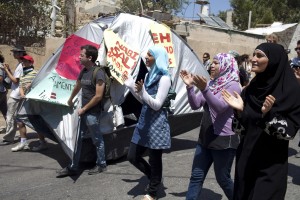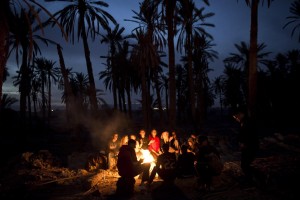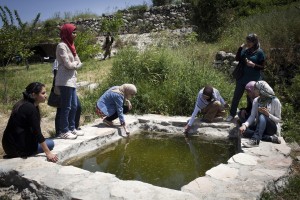Translated by: Margalit Rodgers

Israelis and Palestinians marching and carrying a tent in the weekly demonstration in the village of Nabi Saleh at the same time as the Tent Protest on Rothschild Boulevard in Tel Aviv, 12.08.2011. Moments after the march the demonstration was dispersed with teargas. Oren Ziv / ActiveStills
On July 14, 2011, Daphni Leef placed all her belongings on Rothschild Boulevard in Tel Aviv, an act that inspired thousands of citizens to join her protest against the high cost of living and housing. Masses of people living in public space attracted media coverage and created pressure on government ministers and Knesset members to take a stand on the issue of housing prices. Erecting a tent city and conducting temporary community life in a public space were received with relative agreement by the various authorities, which feared that forcible eviction would only escalate the protest.
Many people from Israel’s social and geographical periphery who saw young middle-class people expressing their protest in the center of Tel Aviv decided that they, too, would erect tent cities in the city’s more southern neighborhoods and in other cities. The economic hardships in these locations, and consequently the demands as well, were and are more acute. The residents of protest camps in the periphery were different from the population in the Rothschild camp; single mothers, people eligible for public housing, refugees, and homeless people. Whereas the police did not patrol the tent camp on Rothschild Boulevard, and allowed a daily routine with hardly any interference, in the periphery the situation was different. In Levinsky Garden in south Tel Aviv, INPA Green Patrol inspectors repeatedly raided the camp and confiscated the tents. The police conducted searches and arrests on the spot, and this was the case in other locations outside Tel Aviv as well.

Erecting the Bab Al Shams protest camp in Area 1E; in the background is the Israeli settlement of Ma’ale Adumim, 12.01.2013. Oren Ziv / ActiveStills
About eighteen months after the Rothschild protest, a similar action in public space took place in the West Bank, but its Palestinian activists actually drew most of their inspiration from the “facts on the ground” policy of the Jewish settlement enterprise. Activists from the Popular Committees – a body uniting activists from various villages – decided to erect a protest camp in an area that Israel calls “1E”. This area, located in the West Bank between Jericho and Jerusalem, is designated in accordance with Israeli government plans dating back to 1991 for the establishment of new Jewish settlements. These settlements will enable Israel to finally sever the northern and southern parts of the West Bank, and connect Ma’ale Adumim to Jerusalem. This plan has been met with harsh international opposition, including from the US State Department, which views it as another step toward annexation of the West Bank and another Israeli action designed to thwart the two-state solution.
Prior to erecting the protest camp, the organizers requested permission from the landowner, a Palestinian from the area, to settle on it. In the early hours of Friday, November 11, hundreds of activists from all over the West Bank arrived at the site and erected a tent city they named “Bab Al Shams” (Arabic lit. “Gate of the Sun”), inspired by the renowned book by Palestinian-Lebanese novelist Elias Khoury. They pitched dozens of tents, a prayer area, and a kitchen. In contrast with Rothschild Boulevard, their action was planned, swift, and efficient, and was completed in just a few hours. The organizers prepared for a prolonged stay in the area and equipped themselves with generators and water tanks. The activists slept there for one night, held meetings, lectures, one protest march, and cultural events. On the second night they were forcibly evicted by more than a thousand Israeli police officers and soldiers.
Similar actions were subsequently held throughout the West Bank, all of them in response to concrete Israeli plans or statements made by government ministers. In February 2013, a protest camp was erected on land belonging to the village of Burin and named Al Manatir[1], which was immediately and forcibly dismantled by the army and settlers from the nearby Jewish settlement of Har Brakha. Another camp was erected and forcibly dismantled in Area 1E during President Obama’s visit to Israel; in February 2014, an additional camp was erected in the Jordan Valley in the vicinity of Ein Hijleh, which was dismantled a week later.
All the protest actions took place in Area C that constitutes about 60% of the West Bank (about 330,000 hectares) in which Israel maintains almost full security and civil control, including over matters pertaining to land ownership and use, such as land allocation, planning, construction, and infrastructures. Consequently, Palestinians building in Area C, even if on private land, still require permits from Israel.

Protest camp erected in the Jordan Valley in protest against annexation of land in the area, 31.01.2014. Oren Ziv / ActiveStills
The “Palestinian Outpost” practice exposed the military and bureaucratic control mechanism that enables Israel’s settlement policy. Palestinians are evicted from their private land by the army, whereas Jewish settlers who take over Palestinian land are backed by the Israeli authorities; from the army that protects them, through the state that enables full connection to infrastructures, to the legal legitimization of outposts and expropriation of Palestinian land under the aegis of the legal system. These camps also highlighted the restrictions imposed on the right to protest of Palestinians in the occupied territories. Part of the military law that has applied to the West Bank and Gaza since 1967 is Military Order 101 Regarding Prohibition of Incitement and Hostile Propaganda. Under its provisions, Palestinians are prohibited from organizing or participating in demonstrations. The evicted “Palestinian Outpost” thus exposes both the dispossession of their land and the prohibition from protesting against it as an ongoing reality.
Moreover, the army’s full control in the West Bank, including the area controlled in practice by the Palestinian Authority, erases the boundary between private and public land, especially when it comes to holding a protest. Not only can the army, at any time, invade any village, agricultural field, school, or the intimate home space of every Palestinian, this is a different kind of erasure. The “Palestinian Outposts” highlighted erasure of a different kind; in order to demonstrate and protest, Palestinians do not go out not into public space, but rather to their private land.

Palestinian women at a spring in the village of Nabi Saleh that was taken over by Jewish settlers, 22.04.2014. Oren Ziv / ActiveStills
At the same time, these actions emphasized the danger of expropriation hovering over the very same land. Annexation, which for the landowners means full dispossession. An example is the Palestinian village of Nabi Saleh near Ramallah with a population of several hundred residents. In 2009, settlers from the nearby Jewish settlement of Halamish began taking over the village’s only spring, situated close to its main access road. In order to take control of the area, the settlers adopted a familiar tactic, establishing a tourist site at the location. Thus, by turning the private Palestinian land into an area for “public” use, the settlers actually prevented Palestinian access to the area. In the case of Nabi Saleh, the tactic was completed. The site was declared an archeological site, as stated on an official sign informing all visitors, despite the fact that no excavations or preservation activities have ever taken place there. Turning an area into an archeological site is usually done in order to preserve a site that holds particular importance and to ensure public access to a place of value. In this and many other instances in the West Bank the meaning of the word “public” is in effect Israeli-Jewish public.
A comparison between the reality of life and protest in Tel Aviv and the West Bank is virtually impossible. However, it is important to try and make it, since through it we can understand the meaning of the separation policy employed by Israel and its implications. For Palestinians, especially in Area C, where in recent years Israel has been concentrating its efforts to take over land en route to full annexation – holding onto the land is an action that binds together survival and protest on a daily basis.
[1] After the traditional stone huts built on agricultural land as shelter for the field watchmen.

